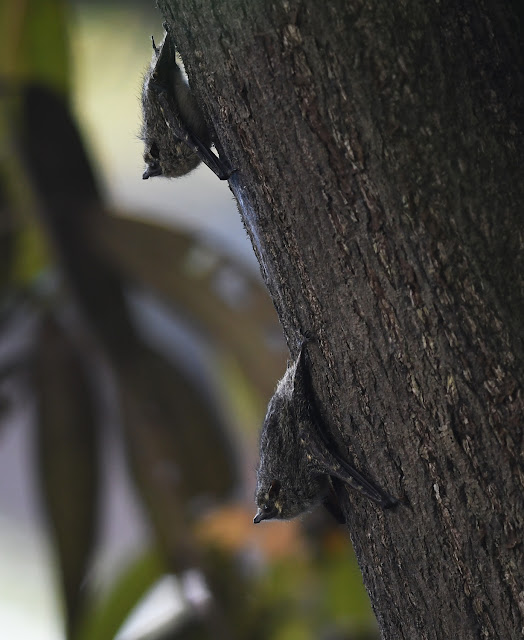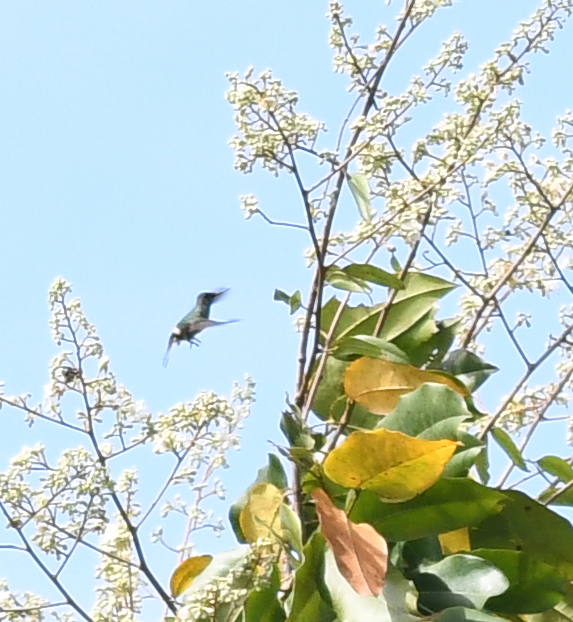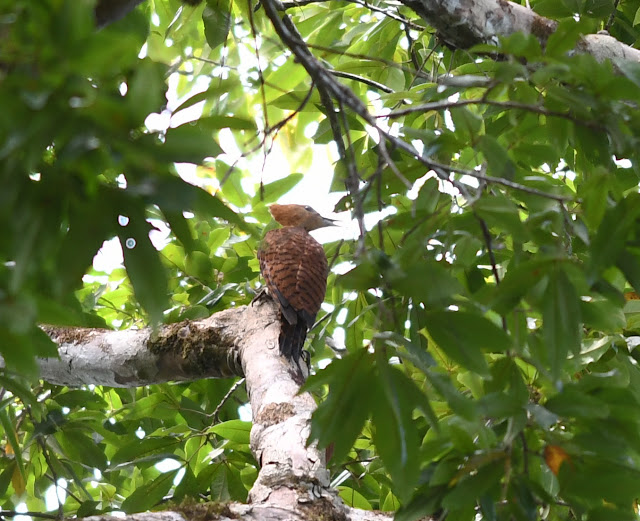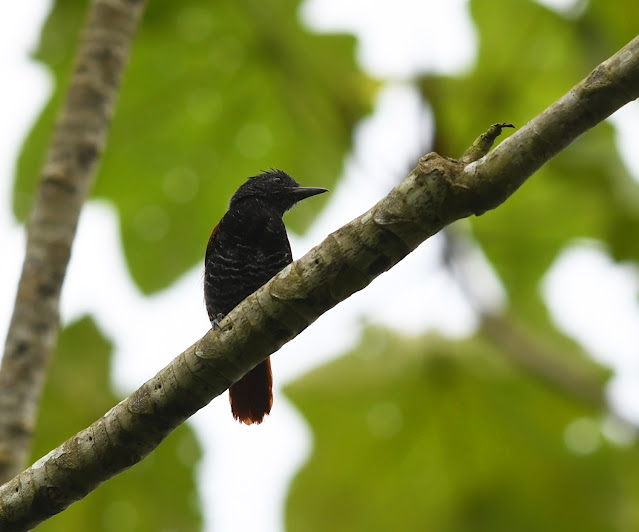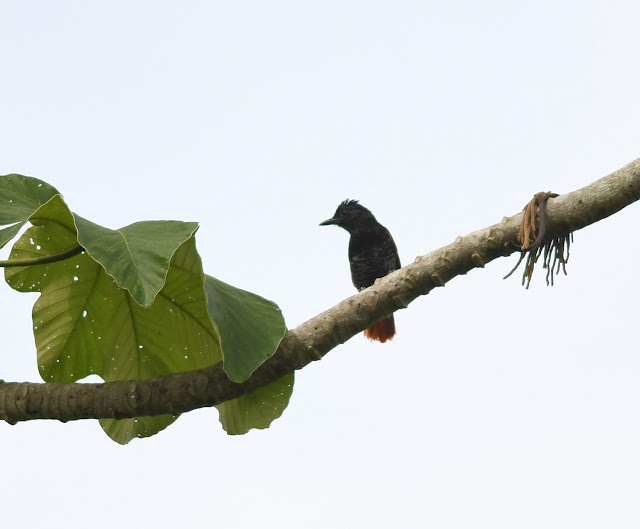February 5, 2022
Laura and I returned to the flooded igapó forest at Matraca to begin our last complete day in the Inírida area. Like our previous visit, we arrived just before sunrise as the dawn chorus was ramping up.
 |
| Matraca, Inírida, Guainía, Colombia |
We found many of the same species that we had observed during our February 1 visit, but I had the added advantage of being more familiar with some of the bird vocalizations. I finally figured out an odd bird song that I had also heard (and recorded) on February 1, but which I had left unidentified at the time. It finally clicked - it was a Cocoa Thrush, and Laura and I successfully tracked one down for brief looks and some very poor photos. Other highlights early on included several Orinoco Softtails, a single Lemon-chested Greenlet high in the canopy, and our first good looks at a Varzea Schiffornis and a new species for our Colombia lists in Black-eared Fairy.
 |
| Varzea Schiffornis - Matraca, Inírida, Guainía, Colombia |
 |
| Black-chinned Antbird - Matraca, Inírida, Guainía, Colombia |
 |
| Speckled Spinetail - Matraca, Inírida, Guainía, Colombia |
Laura spotted a roosting Greater Yellow-headed Vulture in the forest subcanopy. Typically, this is a species that we only see in flight or perched at a great distance so this was a nice surprise.
 |
| Greater Yellow-headed Vulture - Matraca, Inírida, Guainía, Colombia |
The second lifer of the morning was a pair of Black-capped Becards accompanying a mixed flock. While widespread in Amazonia, the Black-capped Becard is uncommon and rarely reported in the Inírida area. Below is a photo of the female.
 |
| Black-capped Becard - Matraca, Inírida, Guainía, Colombia |
We hiked towards the wooden bridge where we had turned around on our February 1 visit. While having a break, we encountered a small group of people who live in the community at the end of the path. We stopped to chat for a few minutes and quickly learned that these people (which included the chief of the community, a woman as Laura was very pleased to see) were out completing trail maintenance. During our conversation, several of the boys procured a fishing line with a hook and went to work catching lunch in the creek. A quick thump on the back of the fish's head, and in the backpack it went. The whole process took no more than two minutes, impressive!
 |
| Gold Wolf Fish (Hoplerythrinus unitaeniatus) - Matraca, Inírida, Guainía, Colombia |
We added a third and final lifer during the walk back to the river. A very fast and distinctive bird song caught my ear, and I believed its owner to be a Cinnamon-rumped Foliage-gleaner. We tracked it down - it was - and managed some nice looks of it. A pretty cool looking foliage-gleaner!
 |
| Cinnamon-rumped Foliage-gleaner - Matraca, Inírida, Guainía, Colombia |
During the rest of our walk we searched the understory and mid-levels of the forest for perched puffbirds. Chestnut-capped and Collared Puffbirds, species we had never encountered before, supposedly inhabit this forest. Unfortunately, we struck out on both, but in a few weeks time we would have a shot at redemption in the forests around Mitú.
 |
| Melinaea ludovica - Matraca, Inírida, Guainía, Colombia |
We returned to Inírida for lunch and a siesta, then returned by boat to Caño Cunubén which is the same site that we explored during the afternoon of February 1. Once again, Yimer carefully manoeuvred the boat past all of the downed trees lurking in the depths of the dark water.
 |
| Caño Cunubén, Guainía, Colombia |
We reached the turn-around spot from February 1 and managed to keep going, since the downed tree across the creek proved to be less of a barrier than we had originally thought. We kept going for another half an hour or so before shutting off the outboard and drifting back down the waterway.
 |
| Rufescent Tiger-Heron - Caño Cunubén, Guainía, Colombia |
 |
| Black-fronted Nunbird - Caño Cunubén, Guainía, Colombia |
 |
| Amazon Kingfisher - Caño Cunubén, Guainía, Colombia |
Yimer dropped a line in the river while we floated and quickly caught several Black-spot Pirahnas!
 |
| Black-spot Pirahna (Pygocentrus cariba) - Caño Cunubén, Guainía, Colombia |
It was another tranquil evening full of bird sightings. Many of these were similar to our previous visit of course but it was hard to tire of sightings of tiger-herons, kingfishers, raptors, woodcreepers, spinetails, antbirds and more.
 |
| Black-collared Hawk - Caño Cunubén, Guainía, Colombia |
 |
| Slate-colored Hawk - Caño Cunubén, Guainía, Colombia |
 |
| Straight-billed Woodcreeper - Caño Cunubén, Guainía, Colombia |
A distant becard at the top of a tree caught my attention. The looks were brief as we only had so much time while we floated past, but we could confirm that it was a Chestnut-crowned Becard, our final new species in Inírida.
 |
| Chestnut-crowned Becard - Caño Cunubén, Guainía, Colombia |
We passed the Olive Oropendola colony one final time and watched the antics of the displaying birds. I was more focused on the Red-rumped Caciques that were also present in small numbers as it was a species that I had never photographed before. The light was tough and they were being uncooperative and so the only photos I managed were record shots.
 |
| Red-rumped Cacique - Caño Cunubén, Guainía, Colombia |
During the boat trip back to town, we observed good numbers of Large-billed Terns, a Pied Lapwing, and a flyover Capped Heron. I held out hope for a surprise Sand-colored Nighthawk at dusk, but that was wishful thinking. As darkness fell we pulled into the dock at Inírida. Another excellent day had come and gone.
February 6, 2022
Laura and I had one final morning in Inírida before our mid-day flight and we considered what to do. In the end, we stayed back at the hotel and had a sleep-in, followed by some time devoted to photo editing, blog post writing, and prepping for the next leg of our adventure. After all, we had seen almost all of our target birds in Inírida with nothing easy left!
At the airport we ran into Camilo, the local guide from Inírida who had patiently answered all of my questions and who had arranged Mario to be our driver. He was returning to Inírida with two North American clients, including Don Cecile who I knew from Ontario. It was great to chat with Don and Camilo for a few minutes before our flight.
Our plane departed almost on time and we left the savannahs and steamy jungles of Inírida behind. We really enjoyed our visit to this relatively untouched corner of Colombia. Until next time...






